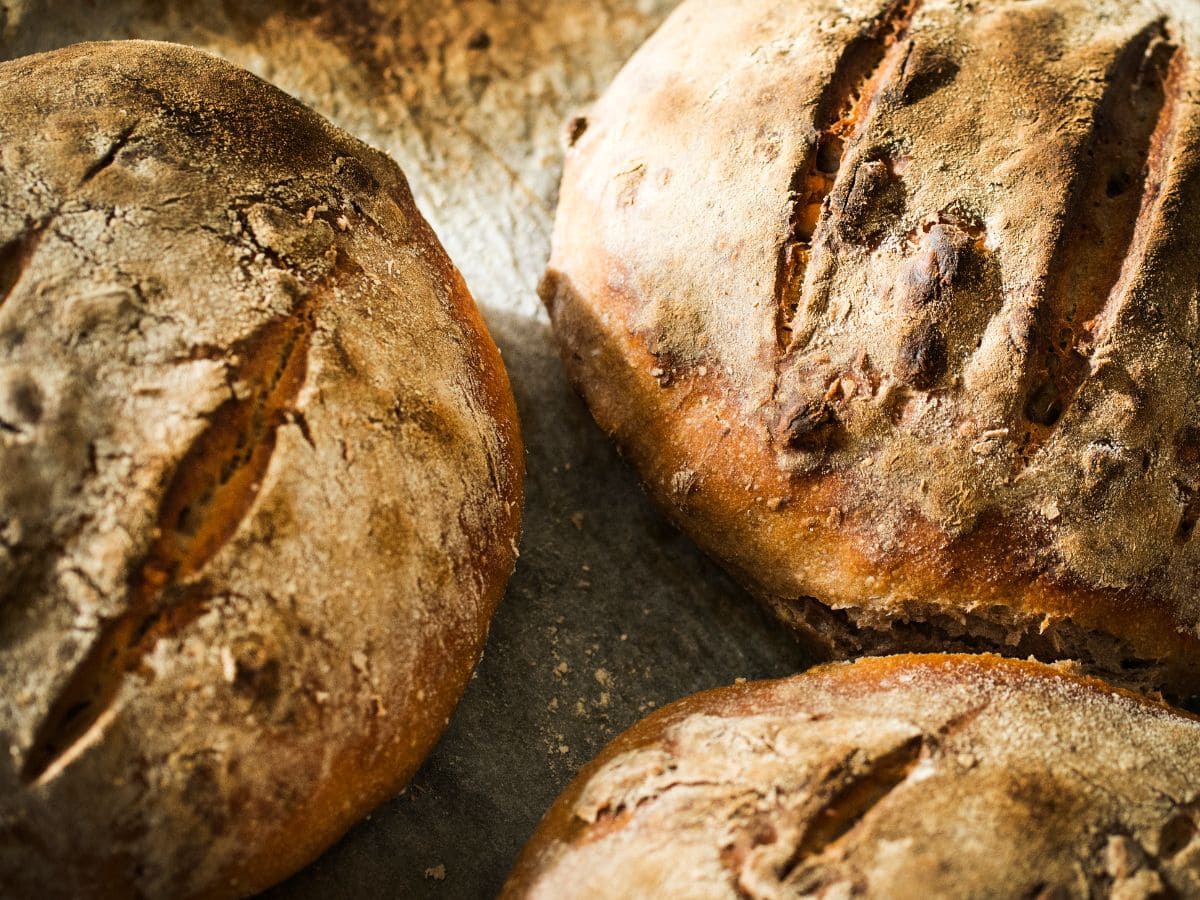
Enjoying sourdough bread at home is incredibly satisfying, but storing it correctly is essential to making it last. After much trial and error, I'm giving you my best tips on how to keep sourdough bread fresh.
Jump to:
- Does sourdough go bad?
- How long can you keep fresh sourdough bread?
- What is the best way to store a fresh loaf of sourdough bread?
- Should sourdough bread be refrigerated?
- How to freeze sourdough bread
- How to use stale sourdough bread?
- What is sourdough?
- Is eating sourdough bread good for you?
- Similar articles
- Fast facts
Does sourdough go bad?
Like any bread, sourdough will go bad eventually.
Here's what to look out for:
- Texture change. If the bread is hard and dry, it's gone stale. Discard or use it in recipes that don't need fresh bread, like french toast, grilled cheese, croutons or breadcrumbs.
- Visible mold. If there's mold on the surface, it's time to toss the loaf.
How long can you keep fresh sourdough bread?

When stored properly, a freshly baked loaf of sourdough bread can stay fresh for 4-5 days. If you plan on eating the bread within that timeframe, you can store it on the countertop. But, if you want the bread to stay fresh for a longer amount of time, you'll need to use your fridge or freezer.
Note: the refrigerator changes the texture of the loaf. So, I personally only use the fridge if I plan on toasting the bread before use.
| Counter | Fridge | Freezer | |
| Fresh sourdough | 5 days | 7 days | 3 months |
If you're wondering why fresh sourdough bread goes bad more quickly than store bought white bread, it's because it is made without preservatives. While it's a pain that it goes stale more quickly, things that are good for my health are always a good thing.
What is the best way to store a fresh loaf of sourdough bread?
The key to keeping sourdough fresh is managing the temperature and humidity it's stored in. Similar to other breads, you want to avoid letting the bread get too warm or too moist, as this will cause it to stale more quickly.
The best way to do this is to store it in a cool, dry place. Below are two of the most popular methods for keeping your sourdough bread fresh longer:
- Breadbox: Let the loaf cool completely, then cover it with a dry tea towel and store it in the box. Note, once sliced, store the loaf cut side down, as it acts a barrier against air.
- Paper bag: Let the loaf cool completely, then wrap your loaf tightly in a clean, dry towel and place it in a paper bag. Transfer it to a cool, dry place like a pantry or cupboard.
Why the tea towel? Well, it absorbs excess moisture from the bread, which is particularly important if you live in a humid environment.
Why a breadbox or paper bag? Both allow air to circulate. This is important because your loaf will retain enough moisture to stop it from drying out, but enough moisture escapes too, ensuring your loaf doesn't go soft or soggy. The bottom line is that breathable storage equals a loaf that retains its signature crunchy texture.
Stored in one of these ways, your loaf should stay fresh for 4-5 days. After that, it is best to freeze the bread to extend its shelf life.
Can you wrap sourdough bread in plastic wrap?
As an alternative to a tea towel, you can wrap your sourdough in plastic wrap. Just be sure that your loaf is completely cooled, as plastic bags can cause condensation that will lead to a soggy loaf. And, no one wants that!
Another option in a pinch is aluminum foil.
Can you store sourdough in a Ziploc bag?
If you don't have a breadbox or paper bag, you can store your sourdough loaf in a Ziplock bag. However, this isn't ideal as plastic bags aren't breathable. Because moisture cannot escape and dry air can't get in, your loaf is likely to turn soggy, and you'll lose your crisp crust.
The below linen bread bag and bread box are great reusable, breathable options.
 Buy Now →
Buy Now →  Buy Now →
Buy Now → Should sourdough bread be refrigerated?
While refrigeration can extend the shelf life of your sourdough bread, it's ideally stored at room temperature.
If you do decide to store your sourdough in the fridge, here's what you should know:
- You'll get an additional 2 days of use.
- The fridge will remove the moisture from your bread, causing the texture to change. Your loaf will be denser, tougher and drier. Because of that, I only store sourdough in the fridge when I plan on toasting it before use.
How to freeze sourdough bread

If you don't think you'll be able to finish a loaf of sourdough within 4-5, you can freeze it to extend its shelf life.
While you can simply freeze the entire loaf, it's best to freeze individual slices so you can quickly enjoy your sourdough from frozen when you're ready to. It may be a little more work on the front end, but I promise it's worth it on the back end.
Here's the best way to freeze sourdough:
- Allow the loaf to cool completely.
- Slice the bread.
- Wrap each slice individually in plastic wrap or tinfoil.
- Place the wrapped slices in a freezer bag, remove as much air as possible, and transfer to the freezer.
- When you're ready to enjoy a slice, simply remove it from the freezer, let it thaw to room temperature and toast.
If you prefer to freeze the entire loaf, the process is the same.
- Allow the loaf to cool completely.
- Wrap the loaf in plastic wrap or tinfoil.
- Place the loaf in a freezer bag, remove as much air as possible, and transfer to the freezer.
- When you're ready to enjoy, remove the loaf from the freezer and let it thaw. Then spritz it with water and place it in a oven at 350°F for 5 minutes before using it as normal.
How to use stale sourdough bread?
If your sourdough has been on the counter for more than 5 days, not all is lost. As long as it's not moldy, you can definitely still use your bread. You just need to get creative!
Here are some ideas for stale sourdough:
- Bread crumbs or croutons: the perfect use for less than fresh bread.
- French toast: covered in batter and toasted, you won't even notice your bread is stale.
- Grilled cheese: like french toast, this is ideal. All you'll notice is the cheesy goodness.
- Soup: dipped in soup, your stale bread will become soft and flavourful!
What is sourdough?

Regular bread is leavened with commercial, packaged yeast. Sourdough, on the other hand, is a naturally leavened bread.
The natural leavener is called a starter. The starter is a mix of flour and water that contains natural yeast and bacteria. When the starter culture is added to dough, it helps the dough to rise and gives the bread a unique, tangy flavor.
Is eating sourdough bread good for you?
A sourdough loaf is delicious and often touted as a healthier alternative to store-bought bread. Here's why:
- Unlike commercial yeast, sourdough starter contains live bacteria and yeasts that helps break down phytic acid, making it easier to digest the bread.
- Sourdough has less gluten than other breads. So, even those with gluten sensitivities can sometimes tolerate it.
- It's packed with nutrients, healthy carbs, fiber, protein and vitamins like folate and iron. And, often higher in many of these nutrients than other breads.
- Sourdough has a lower glycemic index than other breads, meaning it is less likely to spike your blood sugar.
Similar articles
Fast facts
How to keep sourdough bread fresh:
- Sourdough will stay fresh for 4-5 days on your counter
- It's best stored in a cool, dry place in breathable packaging
- The refrigerator will extend it's shelf life by 2 days, but it will have a denser, drier texture
- Sourdough will last 3 months in the freezer
- The best way to store sourdough in the freezer is to slice it first, making it easier to use quickly when you're ready to enjoy it
Now that you know how long sourdough bread lasts, what other foods do you want to learn about? Let me know in the comments below and I'll be sure to answer them as best I can.






Leave a comment!